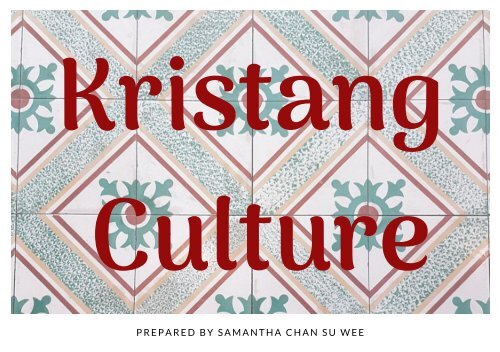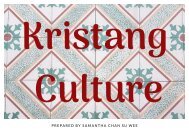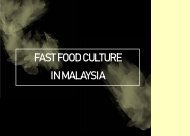KristangCulture
Create successful ePaper yourself
Turn your PDF publications into a flip-book with our unique Google optimized e-Paper software.
Kristang<br />
Culture<br />
P R E P A R E D B Y S A M A N T H A C H A N S U W E E
C O N T E N T S<br />
01 INTRODUCTION<br />
02 HISTORY<br />
03 TIMELINE<br />
04 PAST<br />
05 LANGUAGE<br />
06 RELIGION<br />
07 FESTIVAL
08 MUSIC & DANCE<br />
09 CUISINE<br />
10 PRESENT<br />
11 CHALLENGES &<br />
OPPORTUNITIES
" HAVE YO<br />
HEARD O<br />
KRISTA
U EVER<br />
PAPIA<br />
NG ? "
I N T R O D U C T I O N<br />
Who are they ?<br />
The name 'Kristang' comes from the word Christian,<br />
cristão in Portuguese. Kristang is a creole ethnic group<br />
which has existed for 500 years are descendant of<br />
mixed Portuguese and Malaccan decent in 16th and<br />
17th century. This heritage arose during the<br />
colonization of Portuguese Empire. They are usually<br />
known as 'Portuguese-Eurasians' and 'Malacca<br />
Portuguese'.
H I S T O R Y<br />
In 16th century, due to the superior location of Malacca<br />
Straits, Malacca became one of the major destination of<br />
Portugal sea expeditions and It eventually was Colonized<br />
by the Portuguese Empire in 1511. Due to superstition about<br />
women on ships, Portuguese women were forbidden from<br />
travelling overseas. To strengthen settlement, the<br />
Portuguese government encouraged their explorers such<br />
as sailors to marry local women, under a policy set<br />
by Afonso de Albuquerque, the<br />
Viceroy of India by granting freeman status and<br />
exemption from Crown taxes. The descendants of mixed<br />
Portuguese and Malaccan are known as Kristang. Later<br />
when the dutch and the British colonized Malacca, the<br />
Kristang community expanded further.
T I M E L I N E<br />
16TH<br />
CENTURY<br />
1511<br />
PORTUGUESE CONQUER<br />
MALACCA<br />
18TH<br />
CENTURY<br />
THE COMMUNITY EXPENDED<br />
FURTHER, TO SINGAPORE<br />
?<br />
THE ESTABLISHMENT OF<br />
INTERMARRIAGE<br />
20TH<br />
CENTURY<br />
THE USAGE OF KRISTANG<br />
LANGUAGE WAS DECLINED<br />
17TH<br />
CENTURY<br />
1641<br />
DUTCH TAKEOVER<br />
1604<br />
MIXED MARRIAGES<br />
FLOURISHED AND WAS<br />
RECORDED TO 200<br />
21TH<br />
CENTURY<br />
1933<br />
MIXED PORTUGUESE<br />
SETTLEMENT WAS<br />
BUILT<br />
TO REVIVE ITS CULTURE BY<br />
PROMOTING IT AS A TOURIST<br />
ATTRACTION
P A S T<br />
During Portuguese times, fishing was the major income of the<br />
village as they were living by the sea which have affected their<br />
daily habits and culture. Even today, with only 10 percent of the<br />
community is still making their living by fishing.
" Language is<br />
the vehicle of<br />
culture. "
Their Línggu Mái<br />
(“mother<br />
tongue”)<br />
The Portuguese had colonized Malacca for 150 years.<br />
Approximately 300 Portuguese words were adopted in the<br />
Malay language, Bahasa Melayu. The Kristang language is<br />
formally called Malacca-Melayu Portuguese Creole.<br />
However, it is well known as Papiá Kristáng which means<br />
christian speech. It is also sometimes called Săráni,<br />
“Christian” (cf. Nazarene).The Malay language, Bahasa<br />
Melayu, has changed to incorporate many Kristang words.<br />
For examples, kereta from carreta ( car ),<br />
nenas from ananás ( pineapple )
R E L I G I O N<br />
90% Roman Catholicism<br />
10% Islam
F E S T I V A L<br />
Same with other Catholic communities,<br />
the Kristang celebrate Christmas and a<br />
string of major Saints' days beginning<br />
with St. John (San Juang) on 24 June and<br />
closing with St. Peter (San Pedro), the<br />
fishermen's patron saint, on 29 June. The<br />
June festival of St. John's village is a<br />
major tourist attraction of Malacca.<br />
Tourists come to observe the<br />
festivities.Those festival have gained a<br />
lot of tourist attention, local and<br />
international alike.
Merry<br />
Christmas
Christmas is the most festive event of the<br />
year. Kristang families reunion to<br />
celebrate the festival by eating seasonal<br />
dishes, singing carols and branyok, and<br />
reveling in Saudi. In addition, the<br />
decoration of their house is also another<br />
attraction of that day. Everyone even nonchristian<br />
is welcomed to visit the village.
Intrudu Festival
To know this special community, celebrating the Intrudu Festival is the best<br />
way. It is an increasingly popular water festival in Malacca which is observed<br />
on the Sunday preceding to the Ash Wednesday. It represents the beginning<br />
of self-mortification prior to Lent which comprises Maundy Thursday, Good<br />
Friday, Holy Saturday and Easter Sunday. Here we get to witnessed "Feast of<br />
Saint John" and “Festa San Pedro” festival .
" Beng Nak<br />
Since Kristang are mixed of Portuguese and Malaccan<br />
incuding Malay, Chinese and Indian, the Kristang<br />
cuisine consists of heavy local influence, with the<br />
additions of stews and the inclusion of pork and<br />
seafood in the diet, and rice acts as the staple food.<br />
Among the dishes, the most significant one is the<br />
Devil's Curry which is an extremely spicy dish. Its<br />
complex flavor is said to be relies on Southeast Asian<br />
ingredients like lemongrass and candlenut.
i Kumi !!!<br />
"(“come here to eat”)<br />
Meanwhile, the soy limang terung, silky-smooth<br />
eggplant halves doused in soy sauce mixed with sugar<br />
and lime juice shows the Chinese influence on Kristang<br />
cooking. What makes Kristang cuisine different is<br />
because of its simplicity, on emphasizing good quality<br />
and the freshness of ingredients. Other famous<br />
delicacies include Portuguese grilled fish, pineapple<br />
prawn Curry and Pang Su Si.<br />
Instead of using utensils, Kristang people commonly<br />
eat with their hands .
M U S I C & D A N C E<br />
The Kristang music style is very unique because of its loud<br />
cheerful tone. Their traditional music and dance, such as<br />
the Branyo and the Farrapeira are descendents of<br />
Portuguese folk dances. Their most famous tune is the<br />
'Jinggling Nyonya' which has a happy dance-song routine<br />
and it has eventully become their unofficial "anthem".<br />
The Branyo which descends from the southern Portuguese<br />
folk dance Corridinho had influenced the Malay<br />
joget dance. Besides that, there is also a strong Portuguese<br />
influence on the traditional Malay and Indian orchestras<br />
with the adoption of western music instruments and<br />
musical scales. In dancing field, it requires a lot of<br />
spinning.
P R E S E N T<br />
The culture is nearing extinct<br />
because of several reasons. The<br />
Portuguese settlement was built<br />
to preserve the culture and also<br />
increase the income.
C H A L L E N G E S<br />
Endogamous Religious Law<br />
Religion has been a key challenge as most of the<br />
Eurasians are reluctant to change their religions<br />
and culture identity when intermarriage occurs.<br />
Urbanization<br />
In Portuguese times, residents of the Portuguese<br />
Settlement rely on fishing to make a living, and<br />
nowadays they are at risk of losing their<br />
shoreline. Due to the increasing urbanization<br />
and a changing landscape, the traditional<br />
profession is no longer viable, hence creating a<br />
negative impact on its sense of belonging.
The Loss Of The Language<br />
As the saying goes ' Language is the vehicle of a<br />
culture". The Kristang language is nearing<br />
extinction because it is not taught in schools.<br />
Furthermore, a strong generational shift<br />
towards English is also another reason as during<br />
the 19th century, English became the most<br />
economically useful language around the world.<br />
Plus, new generation is more familiar to English<br />
than Kristang. It can be clearly seen that when<br />
people speak Kristang to each other, but English<br />
to their children. Since lesser people speak the<br />
language, the existence of the culture becomes<br />
extinct.
O P P O R T U N I T I E S
Tourism has been a key catalyst for reviving the dying<br />
Kristang culture in Malacca. The local government aims to<br />
raise the culture awareness by projecting its uniqueness at<br />
key tourist attractions. Furthermore, the mural paintings<br />
depicting Kristang people along Malacca river has been a<br />
recent effort for creating a lasting impact on both local<br />
and international tourists.
“Yo ja prendeh tantu<br />
Kristang!”("I learnt a lot of Kristang")
R E F E R E N C E S<br />
http://lilyrianitravelholic.blogspot.com/2014/<br />
07/kristang-our-portuguese-culture.html<br />
https://joshuaproject.net/people_groups/1124<br />
7/MY<br />
http://majesticmalacca.com/pages/ourstory.html<br />
http://www.destinasian.com/blog/newsbriefs/malacca-kristang-community
A Dying Culture<br />
In Malacca




